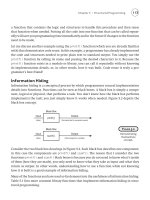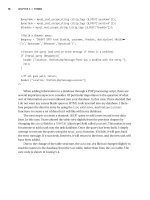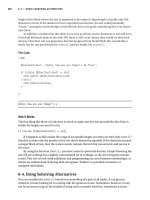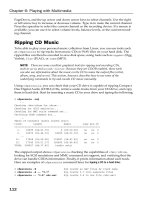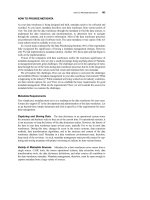PHP for Absolute Beginners PHẦN 5 docx
Bạn đang xem bản rút gọn của tài liệu. Xem và tải ngay bản đầy đủ của tài liệu tại đây (1.19 MB, 41 trang )
CHAPTER 5 BUILDING THE ENTRY MANAGER
145
if(!is_array($e))
{
$fulldisp = 1;
$e = array(
'title' => 'No Entries Yet',
'entry' => '<a href="/admin.php">Post an entry!</a>'
);
}
}
// Return loaded data
}
?>
You can now run your function safely without an error, so long as no entry ID is supplied. Next,
you need to modify the script so it retrieves an entry if an ID is supplied.
This code needs to use the supplied ID in a query to retrieve the associated entry title and
entry fields. As before, you store the returned data in an array called $e.
Add the code in bold to functions.inc.php:
<?php
function retrieveEntries($db, $id=NULL)
{
/*
* If an entry ID was supplied, load the associated entry
*/
if(isset($id))
{
$sql = "SELECT title, entry
FROM entries
WHERE id=?
LIMIT 1";
$stmt = $db->prepare($sql);
$stmt->execute(array($_GET['id']));
// Save the returned entry array
$e = $stmt->fetch();
// Set the fulldisp flag for a single entry
$fulldisp = 1;
}
Download at WoweBook.Com
CHAPTER 5 BUILDING THE ENTRY MANAGER
146
/*
* If no entry ID was supplied, load all entry titles
*/
else
{
$sql = "SELECT id, title
FROM entries
ORDER BY created DESC";
// Loop through returned results and store as an array
foreach($db->query($sql) as $row) {
$e[] = array(
'id' => $row['id'],
'title' => $row['title']
);
}
// Set the fulldisp flag for multiple entries
$fulldisp = 0;
/*
* If no entries were returned, display a default
* message and set the fulldisp flag to display a
* single entry
*/
if(!is_array($e))
{
$fulldisp = 1;
$e = array(
'title' => 'No Entries Yet',
'entry' => '<a href="/admin.php">Post an entry!</a>'
);
}
}
// Return loaded data
}
?>
At this point, your function has two variables: $e and $fulldisp. Both variables must be
returned from the function for further processing; however, a function can return only one value, so you
need to somehow combine these variables into a single variable.
You do this using a function called array_push(), which adds a value to the end of an array.
Using this function, you can add the value of $fulldisp to the end of $e and return $e.
Download at WoweBook.Com
CHAPTER 5 BUILDING THE ENTRY MANAGER
147
You can accomplish this by adding the code in bold to functions.inc.php:
<?php
function retrieveEntries($db, $id=NULL)
{
/*
* If an entry ID was supplied, load the associated entry
*/
if(isset($id))
{
$sql = "SELECT title, entry
FROM entries
WHERE id=?
LIMIT 1";
$stmt = $db->prepare($sql);
$stmt->execute(array($_GET['id']));
// Save the returned entry array
$e = $stmt->fetch();
// Set the fulldisp flag for a single entry
$fulldisp = 1;
}
/*
* If no entry ID was supplied, load all entry titles
*/
else
{
$sql = "SELECT id, title
FROM entries
ORDER BY created DESC";
// Loop through returned results and store as an array
foreach($db->query($sql) as $row) {
$e[] = array(
'id' => $row['id'],
'title' => $row['title']
);
}
// Set the fulldisp flag for multiple entries
$fulldisp = 0;
Download at WoweBook.Com
CHAPTER 5 BUILDING THE ENTRY MANAGER
148
/*
* If no entries were returned, display a default
* message and set the fulldisp flag to display a
* single entry
*/
if(!is_array($e))
{
$fulldisp = 1;
$e = array(
'title' => 'No Entries Yet',
'entry' => '<a href="/admin.php">Post an entry!</a>'
);
}
}
// Add the $fulldisp flag to the end of the array
array_push($e, $fulldisp);
return $e;
}
?>
Writing the Business Function
At this point in your application, the business layer is pretty simple. All you need to do at this point is
escape your output to avoid potential issues. You can accomplish this by writing a function called
sanitizeData(), which you declare right below retrieveEntries() in functions.inc.php.
This function accepts one parameter, $data, and performs basic sanitization using the
strip_tags() function. Sanitizing the function removes all HTML from a string unless a tag is specifically
whitelisted
, or placed in a collection of allowed tags, in strip_tags() second parameter.
The data you pass to sanitizeData() is potentially a mixture of both array and string data, so
you need to check whether $data is an array before you process any data—doing this can help you avoid
any parsing errors.
If $data isn’t an array, you use strip_tags() to eliminate all HTML tags except the <a> tag; this
enables your entries to contain links.
If $data
is
an array, you use the array_map() function to call sanitizeData()
recursively
on each
element in the array.
Recursive Functions
In some cases, it becomes necessary to call a function from within itself. This technique is known as a
recursive function call, and it has a number of useful applications. In this instance, you use recursion to
ensure that every element in an array is sanitized, no matter how deep your array goes. In other words,
the first element contains an array where its first element is another array, and so on. Recursion allows
your function to be called repeatedly until you reach the bottom of the array.
Download at WoweBook.Com
CHAPTER 5 BUILDING THE ENTRY MANAGER
149
Sanitizing the Data
The next step is to declare sanitizeData() and write the code to perform the recursive technique just
described. Add this code to functions.inc.php, just below retrieveEntries():
function sanitizeData($data)
{
// If $data is not an array, run strip_tags()
if(!is_array($data))
{
// Remove all tags except <a> tags
return strip_tags($data, "<a>");
}
// If $data is an array, process each element
else
{
// Call sanitizeData recursively for each array element
return array_map('sanitizeData', $data);
}
}
Writing the Presentation Code
Your last step in this phase of creating the blog is to use the information retrieved and formatted by your
database and business layers to generate HTML markup and display the entries.
You will write this code in index.php inline with the HTML markup. The reason for this
approach: This code is strictly for inserting your processed data into HTML markup.
Begin by including both db.inc.php and functions.inc.php in index.php. At the very top of
index.php, add the following code:
<?php
/*
* Include the necessary files
*/
include_once 'inc/functions.inc.php';
include_once 'inc/db.inc.php';
?>
Next, you need to open a connection to the database. You also need to check whether an entry
ID was passed in the URL.
Download at WoweBook.Com
CHAPTER 5 BUILDING THE ENTRY MANAGER
150
Note Passing entry IDs in the URL (
i.e.
, http://localhost/simple_blog/??id=1 is a popular and
straightforward way of using one page to display different entries. You accomplish this in PHP using the $_GET
superglobal.
Now add the bold lines to index.php:
<?php
/*
* Include the necessary files
*/
include_once 'inc/functions.inc.php';
include_once 'inc/db.inc.php';
// Open a database connection
$db = new PDO(DB_INFO, DB_USER, DB_PASS);
// Determine if an entry ID was passed in the URL
$id = (isset($_GET['id'])) ? (int) $_GET['id'] : NULL;
?>
So far, you’ve determined whether an ID is set using the ternary operator, which allows you to
compress an if statement into one line. Translated into plain English, the previous code snippet would
read like this: “if $_GET['id'] is set to some value, save its value as an integer in $id, or else set the value
of $id to NULL.”
Next, you need to load the entries from the database. Do this by calling your retrieveEntries()
function and passing it your database connection ($db) and the ID you collected ($id) as parameters.
Now add the lines in bold to index.php:
<?php
/*
* Include the necessary files
*/
include_once 'inc/functions.inc.php';
include_once 'inc/db.inc.php';
// Open a database connection
$db = new PDO(DB_INFO, DB_USER, DB_PASS);
Download at WoweBook.Com
CHAPTER 5 BUILDING THE ENTRY MANAGER
151
// Determine if an entry ID was passed in the URL
$id = (isset($_GET['id'])) ? (int) $_GET['id'] : NULL;
// Load the entries
$e = retrieveEntries($db, $id);
?>
The appropriate entries for the page are stored in the $e array and are ready to be displayed.
You know that the last element of the array contains a flag telling you whether a full entry is stored, so
your next step is to pop the last element off the array and store it in a variable ($fulldisp) that you’ll use
in just a moment.
Also, you need to sanitize the entry data, which we do by calling sanitizeData() and passing $e
as the parameter. Next, add the lines in bold to index.php:
<?php
/*
* Include the necessary files
*/
include_once 'inc/functions.inc.php';
include_once 'inc/db.inc.php';
// Open a database connection
$db = new PDO(DB_INFO, DB_USER, DB_PASS);
// Determine if an entry ID was passed in the URL
$id = (isset($_GET['id'])) ? (int) $_GET['id'] : NULL;
// Load the entries
$e = retrieveEntries($db, $id);
// Get the fulldisp flag and remove it from the array
$fulldisp = array_pop($e);
// Sanitize the entry data
$e = sanitizeData($e);
?>
At this point, you have a flag to let you know whether you’re displaying a full entry or a list of
entry titles ($fulldisp), as well as an array of information to insert into HTML markup ($e).
To create the output, you need to determine whether the flag is set to 1, which would signify a
full entry. If so, you insert the entry title into an <h2> tag and place the entry in a <p> tag.
Download at WoweBook.Com
CHAPTER 5 BUILDING THE ENTRY MANAGER
152
In index.php, in the middle of the page below <div id="entries">, add the following lines of
bold code:
<div id="entries">
<?php
// If the full display flag is set, show the entry
if($fulldisp==1)
{
?>
<h2> <?php echo $e['title'] ?> </h2>
<p> <?php echo $e['entry'] ?> </p>
<p class="backlink">
<a href="./">Back to Latest Entries</a>
</p>
<?php
} // End the if statement
?>
<p class="backlink">
<a href="/admin.php">Post a New Entry</a>
</p>
</div>
Navigating to the http://localhost/simple_blog/?id=1 address enables you to see the first
entry (see Figure 5-7).
Download at WoweBook.Com
CHAPTER 5 BUILDING THE ENTRY MANAGER
153
Figure 5-7. The first entry loaded using a variable passed in the URL
Next, you need to determine how you should display your list of entry titles. Ideally, you want to
show the title as a link that takes the user to view the full entry.
This list of links is displayed if the $fulldisp flag is set to 0, so add an else to the conditional
statement that checks whether $fulldisp is set to 1. Inside the else statement, you need to create a loop
to process each paired ID and title together.
Just after the if statement, add the bold lines of code to index.php:
<?php
} // End the if statement
// If the full display flag is 0, format linked entry titles
else
{
// Loop through each entry
foreach($e as $entry) {
?>
<p>
<a href="?id=<?php echo $entry['id'] ?>">
<?php echo $entry['title'] ?>
</a>
</p>
Download at WoweBook.Com
CHAPTER 5 BUILDING THE ENTRY MANAGER
154
<?php
} // End the foreach loop
} // End the else
?>
<p class="backlink">
<a href="/admin.php">Post a New Entry</a>
</p>
</div>
Now, navigate to http://localhost/simple_blog/, and you should see the title of each entry
listed as a link(see Figure 5-8). Clicking any of the links takes you to the associated entry.
Figure 5-8. The title of each entry is listed as a link
Download at WoweBook.Com
CHAPTER 5 BUILDING THE ENTRY MANAGER
155
Fix the Redirect
Now that index.php exists, you want to be taken to your new entries after they are submitted. To do this,
you need to change the address of the header() calls to take the user to index.php. Change the code in
bold in update.inc.php to make this happen:
<?php
if($_SERVER['REQUEST_METHOD']=='POST'
&& $_POST['submit']=='Save Entry')
{
// Include database credentials and connect to the database
include_once 'db.inc.php';
$db = new PDO(DB_INFO, DB_USER, DB_PASS);
// Save the entry into the database
$sql = "INSERT INTO entries (title, entry) VALUES (?, ?)";
$stmt = $db->prepare($sql);
$stmt->execute(array($_POST['title'], $_POST['entry']));
$stmt->closeCursor();
// Get the ID of the entry we just saved
$id_obj = $db->query("SELECT LAST_INSERT_ID()");
$id = $id_obj->fetch();
$id_obj->closeCursor();
// Send the user to the new entry
header('Location: /?id='.$id[0]);
exit;
}
// If both conditions aren't met, sends the user back to the main page
else
{
header('Location: /');
exit;
}
?>
Download at WoweBook.Com
CHAPTER 5 BUILDING THE ENTRY MANAGER
156
Summary
You have now created a blog in the basic sense! Basic techniques you learned in this chapter included:
• How to use a web form to create and save entries in the database
• How to retrieve and display entries based on variables passed in the URL
As you continue on, you’ll add several cool features to the blog, including a formatted date,
authoring information, and images. In the next chapter, you’ll learn how to make your blog support
multiple pages, which in turn will enable you to build an “About the Author” page.
Download at WoweBook.Com
C H A P T E R 6
157
Adding Support for Multiple
Pages
So far you’ve created an extremely basic blog. But what good is a blog if a user can’t find out more about
its author?
In this chapter, you’ll learn how to modify your application to support multiple pages, so you
can add an “About the Author” page. To do this requires that you learn how to accomplish each of the
following steps:
• Add a page column to the entries table
• Modify functions to use a page as part of the WHERE clause in your MySQL query
• Add a hidden input to the form on admin.php to store the page
• Modify update.inc.php to save page associations in the database
• Use an .htaccess file to create friendly URLs
• Add a menu
• Modify display options for the “About the Author” and “Blog” pages
By the end of this chapter, your blog will have two pages: one will support multiple entries,
while the other will support only a single entry.
Add a page Column to the entries Table
Your first task is learning to identify what entries belong on what page. Essentially, you need to add a
page identifier. This could be a number or a string. Your application is pretty simple, so you can just use
the name of the page as your identifier.
To add this to your entries, you need to get back into your database controls, located at
http://localhost/phpmyadmin. Open the simple_blog database, then the entries table. You need to add
a column called page to the entries table, which will hold the name of the page to which each entry
belongs.
This column cannot be blank, or the entries will get lost. To avoid this, you can set the column
to NOT NULL and provide a default value. Most entries will end up on the blog page, so set the default to
“blog.” Finally, for organizational purposes, you want to put the column right after the id column; you
can accomplish this in your query by using AFTER id.
Additionally, you can speed up your queries by adding an index to the page column. This is as
simple as appending ADD INDEX (page) to the end of the query, separated by a comma. The full query
looks like this:
Download at WoweBook.Com
CHAPTER 6 ADDING SUPPORT FOR MULTIPLE PAGES
158
ALTER TABLE entries
ADD page VARCHAR(75) NOT NULL DEFAULT 'blog'
AFTER id,
ADD INDEX (page)
Now execute the preceding query in the SQL tab of http://localhost/phpmyadmin. When the
query finishes, click the Browse tab to verify that the page column has been created and that all the
pages have been identified as blogs.
Modify Your Functions to Accept Page Parameters
Now that your entries have a page associated with them, you can start using the page as a
filter
to
retrieve only the data that matches your current page. This is really similar to the way you used the id
column to filter your query to only return one entry. By using the page, you filter the query to only return
entries for one page.
Accepting Page Information in the URL
First—and this is very important—you need to somehow pass a page variable to your script. You do this
in the same way that you previously passed an entry ID to the script, using the URL and the $_GET
superglobal.
For example, you navigate to the following address to look at the blog page:
http://localhost/simple_blog/?page=blog
Navigating to an entry within the blog requires that you use a URL similar to the following:
http://localhost/simple_blog/?page=blog&id=2
To use the preceding URL format, you need to modify index.php to use the page variable passed
in the URL, then modify functions.inc.php to accept the page variable and use it in your database
query.
Begin by opening index.php (full path: /xampp/htdocs/simple_blog/index.php) and adding the
code in bold to the top of the script:
<?php
/*
* Include the necessary files
*/
include_once 'inc/functions.inc.php';
include_once 'inc/db.inc.php';
// Open a database connection
$db = new PDO(DB_INFO, DB_USER, DB_PASS);
Download at WoweBook.Com
CHAPTER 6 ADDING SUPPORT FOR MULTIPLE PAGES
159
/*
* Figure out what page is being requested (default is blog)
* Perform basic sanitization on the variable as well
*/
if(isset($_GET['page']))
{
$page = htmlentities(strip_tags($_GET['page']));
}
else
{
$page = 'blog';
}
// Determine if an entry ID was passed in the URL
$id = (isset($_GET['id'])) ? (int) $_GET['id'] : NULL;
// Load the entries
$e = retrieveEntries($db, $page, $id);
// Get the fulldisp flag and remove it from the array
$fulldisp = array_pop($e);
// Sanitize the entry data
$e = sanitizeData($e);
?>
Here you add a line that collects the page variable from the $_GET superglobal array, then
assigns its value (or a default value, which you’ve set to “blog”) to a variable called $page.
Next, you add the $page variable as an argument in your call to retrieveEntries($db, $
$page,
$id); so that you can use the information in retrieving entry data.
For now, you’re finished in index.php. Next, you need to modify your retrieveEntries()
function.
Using the Page Information to Filter Entries
The first thing you need to do is to alter retrieveEntries() to accept the $page parameter you’ve just
added. Open functions.inc.php and alter the function definition to read as follows:
function retrieveEntries($db, $page, $url=NULL)
{
The page is being sent to your entry retrieval function, so you can use the information to filter
your query and return only results relevant to the page being viewed. You accomplish this using a WHERE
clause.
Download at WoweBook.Com
CHAPTER 6 ADDING SUPPORT FOR MULTIPLE PAGES
160
Originally, your query for retrieving entries when no entry ID was supplied looked like this:
SELECT id, title, entry
FROM entries
ORDER BY created DESC
Adding the WHERE clause means you can no longer simply execute the query because you’re now
relying on user-supplied data, which is potentially dangerous. To keep your script secure, you need to
use a prepared statement. Your query uses a placeholder for the page variable and looks something like
this:
SELECT id, page, title, entry
FROM entries
WHERE page=?
ORDER BY created DESC
Now you can retrieve only the entries that correspond to the page being viewed. The next step is
to update your query in functions.inc.php (full path:
/xampp/htdocs/simple_blog/inc/functions.inc.php). This snippet starts at line 25 in the file; add the
changes highlighted in bold:
/*
* If no entry ID was supplied, load all entry titles f
for the page
*/
else
{
$sql = "SELECT id, page, title, entry
FROM entries
WHERE page=?
ORDER BY created DESC";
$stmt = $db->prepare($sql);
$stmt->execute(array($page));
$e = NULL; // Declare the variable to avoid errors
In this snippet, you create a prepared statement out of the query you wrote previously, then
execute the statement using the $page variable you passed to retrieveEntries() from index.php.
This code also adds a line declaring the $e variable as NULL. This part serves as a precautionary
measure against empty result sets, which would otherwise result in an error notice if no entries exist for
the specified page.
Tip It’s a good habit to get into to always declare a variable as NULL if there’s the potential for a query or loop to
come back empty. This means any variable defined in a conditional statement or used to store the result of a
database query should contain a
NULL value before the query or loop is executed.
Download at WoweBook.Com
CHAPTER 6 ADDING SUPPORT FOR MULTIPLE PAGES
161
You changed the method you use to execute the query, so now you need to modify the way you
store the result set. Add the following code in bold where indicated in functions.inc.php, immediately
beneath the script you just altered, starting at line 39:
// Loop through returned results and store as an array
while($row = $stmt->fetch()) {
$e[] = $row;
}
Once this code is in place, each result array is stored as an array element in $e; this means that
your script will now work. Save functions.inc.php and navigate to http://localhost/simple_blog/
?page=blog in a browser. At this point, you should see the previews of the blog entry (see Figure 6-1).
Figure 6-1. The blog previews page loaded with URL variables
The blog is the default page, so previews will also load without the page variable. To see the
power of what you’ve just built, navigate to a page that doesn’t exist yet: your “About the Author” page.
Navigate to http://localhost/simple_blog/?page=about in a browser, and you should see your default
“No Entries” message (see Figure 6-2).
Download at WoweBook.Com
CHAPTER 6 ADDING SUPPORT FOR MULTIPLE PAGES
162
Figure 6-2. The “About the Author” page with no entries supplied
Here you face with a slight problem: you have a “Back to Latest Entries” link on your “About the
Author” page. This could prove misleading because it might give your users the impression that there are
more entries about the author.
Additionally, the “Post a New Entry” link appears on this page. You want only one entry to
appear on the “About the Author” page, so you don’t want this link to appear here.
To correct this, you must modify index.php with a conditional statement that displays the “Back
to Latest Entries” and “Post a New Entry” links only on the “Blog” page. Accomplish this by opening
index.php and adding the code in bold to the body of the document:
<!DOCTYPE html
PUBLIC "-//W3C//DTD XHTML 1.0 Strict//EN"
"
<html xmlns=" xml:lang="en" lang="en">
<head>
<meta http-equiv="Content-Type"
content="text/html;charset=utf-8" />
<link rel="stylesheet" href="css/default.css" type="text/css" />
<title> Simple Blog </title>
</head>
Download at WoweBook.Com
CHAPTER 6 ADDING SUPPORT FOR MULTIPLE PAGES
163
<body>
<h1> Simple Blog Application </h1>
<div id="entries">
<?php
// If the full display flag is set, show the entry
if($fulldisp==1)
{
?>
<h2> <?php echo $e['title'] ?> </h2>
<p> <?php echo $e['entry'] ?> </p>
<?php if($page=='blog'): ?>
<p class="backlink">
<a href="./">Back to Latest Entries</a>
</p>
<?php endif; ?>
<?php
} // End the if statement
// If the full display flag is 0, format linked entry titles
else
{
// Loop through each entry
foreach($e as $entry) {
?>
<p>
<a href="?id=<?php echo $entry['id'] ?>">
<?php echo $entry['title'] ?>
</a>
</p>
<?php
} // End the foreach loop
} // End the else
?>
Download at WoweBook.Com
CHAPTER 6 ADDING SUPPORT FOR MULTIPLE PAGES
164
<p class="backlink">
<?php if($page=='blog'): ?>
<a href="/simple_blog/admin/<?php echo $page ?>">
Post a New Entry
</a>
<?php endif; ?>
</p>
</div>
</body>
</html>
Now you don’t see the potentially misleading links when you load
http://localhost/simple_blog/?page=about (see Figure 6-3).
Figure 6-3. The “About the Author” page without potentially misleading links
The next step is to create an entry for the “About the Author” page. However, you need to
update your admin.php script before you can create this entry.
Download at WoweBook.Com
CHAPTER 6 ADDING SUPPORT FOR MULTIPLE PAGES
165
Modifying admin.php to Save Page Associations
Saving the page an entry is associated with is as easy as adding another input to your form. However,
there are a couple reasons you don’t want to require the user to fill out the page an entry belongs on.
First, it’s inconvenient for the user; second, it increases the risk of typos or confusion.
Fortunately, HTML forms allow you to insert
hidden inputs
, which contain a value that is
passed in the $_POST superglobal, but isn’t displayed to the user. In your admin.php script (full path:
/xampp/htdocs/simple_blog/admin.php), add a hidden input to your form by inserting the lines in bold:
<?php
if(isset($_GET['page']))
{
$page = htmlentities(strip_tags($_GET['page']));
}
else
{
$page = 'blog';
}
?>
<!DOCTYPE html
PUBLIC "-//W3C//DTD XHTML 1.0 Strict//EN"
"
<html xmlns=" xml:lang="en" lang="en">
<head>
<meta http-equiv="Content-Type"
content="text/html;charset=utf-8" />
<link rel="stylesheet"
href="/simple_blog/css/default.css" type="text/css" />
<title> Simple Blog </title>
</head>
<body>
<h1> Simple Blog Application </h1>
<form method="post" action="/simple_blog/inc/update.inc.php">
<fieldset>
<legend>New Entry Submission</legend>
<label>Title
<input type="text" name="title" maxlength="150" />
</label>
<label>Entry
<textarea name="entry" cols="45" rows="10"></textarea>
</label>
Download at WoweBook.Com
CHAPTER 6 ADDING SUPPORT FOR MULTIPLE PAGES
166
<input type="hidden" name="page"
value="<?php echo $page ?>" />
<input type="submit" name="submit" value="Save Entry" />
<input type="submit" name="submit" value="Cancel" />
</fieldset>
</form>
</body>
</html>
In the first line of this script, you retrieve the page variable, which will be passed in the URL.
To make sure a variable was passed, you use the
ternary operator
(a shortcut syntax for the if else
statement) to check whether $_GET['page'] is set. If so, you perform basic sanitization by removing any
HTML tags from the string, then encoding any special characters that could cause problems in your
script. If not, you provide a default page, blog, to avoid any unexpected behavior.
Then, in the form itself, you insert a hidden input with the name of “page” and a value that
contains the sanitized value from the URL.
This means that creating an entry with an associated page requires that you access admin.php
using a path that includes a page variable:
http://localhost/simple_blog/admin.php?page=about
This means that you need to make some adjustments to index.php to ensure that a page
variable is passed when a user clicks the link to create a new entry.
In index.php, starting at line 100, modify the link to create a new entry as follows:
<p class="backlink">
<a href="/simple_blog/admin.php?page=<?php echo $page ?>">
Post a New Entry
</a>
</p>
This entry takes the $page variable you stored at the beginning of the script and uses it to make
a link for posting a new entry pass to the page. You can test this by navigating to
http://localhost/simple_blog/?page=about; this URL lets you use your browser to look at the page
value stored in the “Post a New Entry” link (see Figure 6-4).
Tip You can view the source code in a PHP project by select View from the browser menu, then (depending on
the browser being used) Source, Page Source, or View Source.
Download at WoweBook.Com
CHAPTER 6 ADDING SUPPORT FOR MULTIPLE PAGES
167
Figure 6-4. The source code of
http://localhost/simple_blog/?page=about
Next, you need to make sure that you’re storing the page in the hidden input properly. Click the
“Post a New Entry” link on http://localhost/simple_blog/?page=about, which should direct you to
http://localhost/simple_blog/admin.php?page=about. There, you can see your form as usual, but
looking at the source code should reveal that the hidden input now contains the “about” value that was
passed in the URL (see Figure 6-5).
Figure 6-5. The source of
http://localhost/simple_blog/admin.php?page=about
Download at WoweBook.Com
CHAPTER 6 ADDING SUPPORT FOR MULTIPLE PAGES
168
Now you know that the page will be passed to the form. This means that you have access, via
the $_POST superglobal, to whatever page the entry is associated with after the new entry is submitted.
However, bear in mind that the page association won’t be saved until you make some
adjustments to update.inc.php to handle this new information.
Saving Page Associations
Saving the page association in your database when new entries are created requires that you modify
your query in update.inc.php, as well as a couple more checks to ensure that errors don’t occur.
To save the entry information, you need to:
1. Make sure the page was specified before processing
2. Add the page to the query to be saved
3. Sanitize the data
4. Use the sanitized page information to send the user back to the created entry
In update.inc.php, modify the script to include the lines highlighted in bold:
<?php
if($_SERVER['REQUEST_METHOD']=='POST'
&& $_POST['submit']=='Save Entry'
&& !empty($_POST['page'])
&& !empty($_POST['title'])
&& !empty($_POST['entry']))
{
// Include database credentials and connect to the database
include_once 'db.inc.php';
$db = new PDO(DB_INFO, DB_USER, DB_PASS);
// Save the entry into the database
$sql = "INSERT INTO entries (page, title, entry)
VALUES (?, ?, ?)";
$stmt = $db->prepare($sql);
$stmt->execute(
array($_POST['page'],$_POST['title'],$_POST['entry'])
);
$stmt->closeCursor();
// Sanitize the page information for use in the success URL
$page = htmlentities(strip_tags($_POST['page']));
Download at WoweBook.Com
CHAPTER 6 ADDING SUPPORT FOR MULTIPLE PAGES
169
// Get the ID of the entry you just saved
$id_obj = $db->query("SELECT LAST_INSERT_ID()");
$id = $id_obj->fetch();
$id_obj->closeCursor();
// Send the user to the new entry
header('Location: /simple_blog/?page='.$page.'&id='.$id[0]);
exit;
}
else
{
header('Location: /');
exit;
}
?>
Making these changes, effectively ensures that a page association is passed to the update script;
you can then insert the association using your prepared statement. Afterward, you sanitize the page
information and store it in the $page variable. Finally, you send the user to the new entry by passing the
page in the URL, along with the ID of the new entry.
Save update.inc.php and navigate to http://localhost/simple_blog/?page=about, then click
the “Post a New Entry” link. Now create an “About the Author” entry and click “Save Entry”; this should
take you to the entry saved with the “about” page association (see Figure 6-6).
Figure 6-6. The “About the Author” page with an entry created
Download at WoweBook.Com



